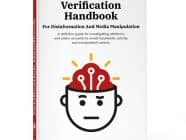Digital journalists who mine user generated content now have a new tool available. The European Journalism Centre asked a team of respected media analysts including Anthony De Rosa (Circa), Mathew Ingram, Craig Silverman (Poynter) and Steve Buttry to write a book on how best to use UGC. The book is designed to help journalists reporting on crisis situations to avoid the pitfalls involved in using social media as a source of information. The book “The Verification Handbook” is available online in Creative Commons and in ebook format.
As the title implies, the book is a guide to the verification of digital content and in its 10 chapters it offers theoretical and practical tips on how to closely inspect videos, images and other UGC, describing representative case studies which illustrate the strategy used in different circumstances. Speaking about the severe humanitarian crisis in the Nigerian city of Jos, for example, Stèphanie Durand (from the United Nations Alliance of Civilizations) says that “social media perpetuate misinformation, while at the same time enabling journalists to connect and interact with members of the public as part of their work”. Durand continues: “Social media also provide a platform to respond to rumors, and verify information that ultimately creates the type of trust and transparency necessary to avoid an escalation of conflict”.
Indeed, one of the key points about the use of social media in a crisis is that first, it should do no harm. As Mat Honan wrote some time ago in Wired, the best response of Twitter users not directly involved in a tragedy is silence so as not to create confusion or risk smothering important and useful information with noise.
Learning how to cut through the confusion inherently present in social media is crucial and makes verification “the essence of journalism” writes Steve Buttry in his piece on how the ways of accurately verifying news have evolved over time, adapting to the new technologies. These new technologies have without doubt contributed positively to news creation but they have also made it easier to manipulate content or even create new content for propaganda purposes. Because of this, writes Buttry, “the ease of digital video editing – like that of other digital techniques -, “raises the importance of skepticism”. In this respect the reflections made by Malachy Browne from Storyful are very interesting; in the book he describes how he factchecked a video posted on YouTube by an athlete in the Boston marathon which showed the explosion along the route, by astutely cross-referencing commonly used digital tools such as Google Street View and Twitter.
Mathew Ingram writes about the importance of knowing how to create a network of reliable sources on Twitter that can be consulted if need be. Another excellent example provided by the senior writer with GigaOm is that of Andy Carvin of the Npr and his “Twitter newsroom” of sources in the Middle Eastern countries affected by the Arab Spring with which. He follows them on Twitter but has also developed a relationship of mutual trust on the basis of which verified and trustworthy information can be obtained. In one case, a photograph of a mortar which exploded in Libya was sent to Carvin and broadcast to his network of Twitter contact. Carvin’s sources helped him identify the type of weapon and its country of production, making it possible to affirm that the bomb was not Israeli. What Ingram calls “responsible crowdsourcing” is also the working method used by Brown Moses, the English blogger who reveals the characteristics of the weapons used in Syria, an activity which has already earned him the status of verified source on the subject for many international media outlets.
The final chapter of the Verification Handbook lists some of the digital tools that journalists can use to fact check UGC content. The list is divided into three different categories: verification of the identity of the sources; localisation of the content; and verification of the truthfulness of images. A more than complete starting point for the verification of digital material – a linchpin of journalistic practice and by no means an exception – as the BBC has done for years with its Verification Hub.
This article was translated by Anne Jamieson from the Italian “Verifica delle fonti, una guida per il digitale.”
Tags: Digital Media, Journalism, New media, New technology, sources, verification, verification handbook, Verifying Sources















































